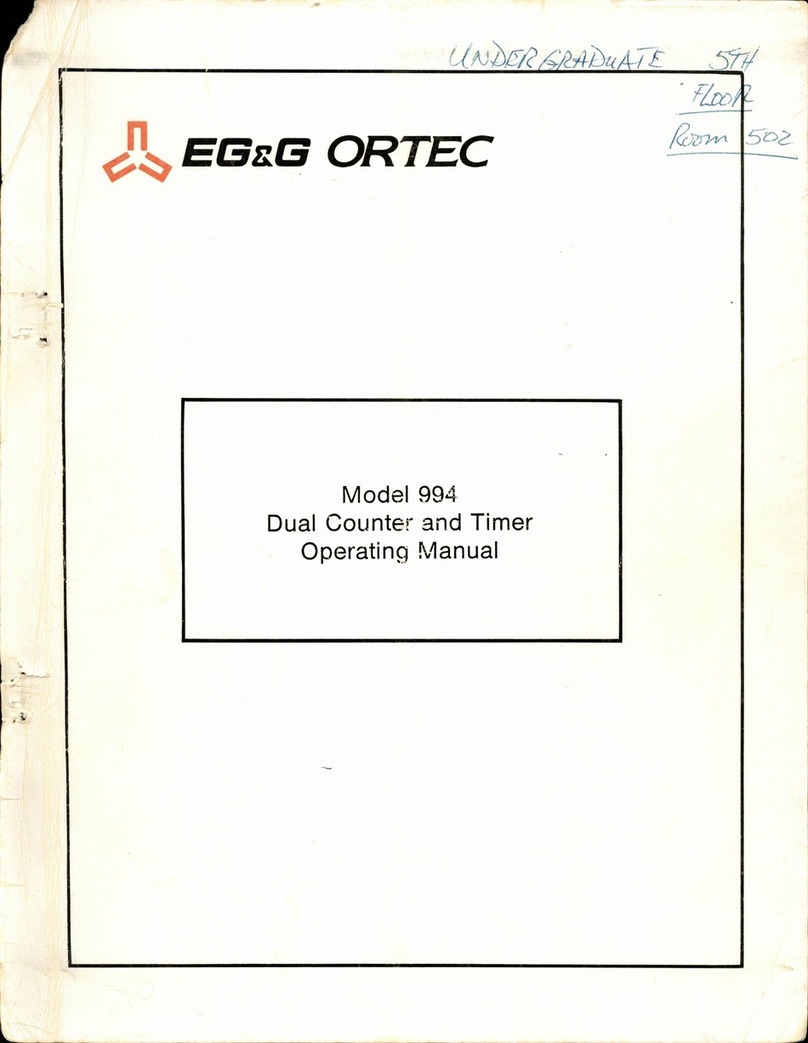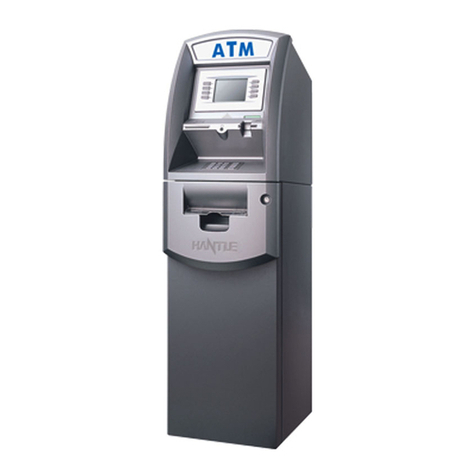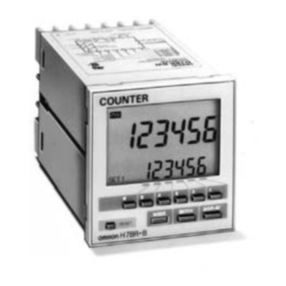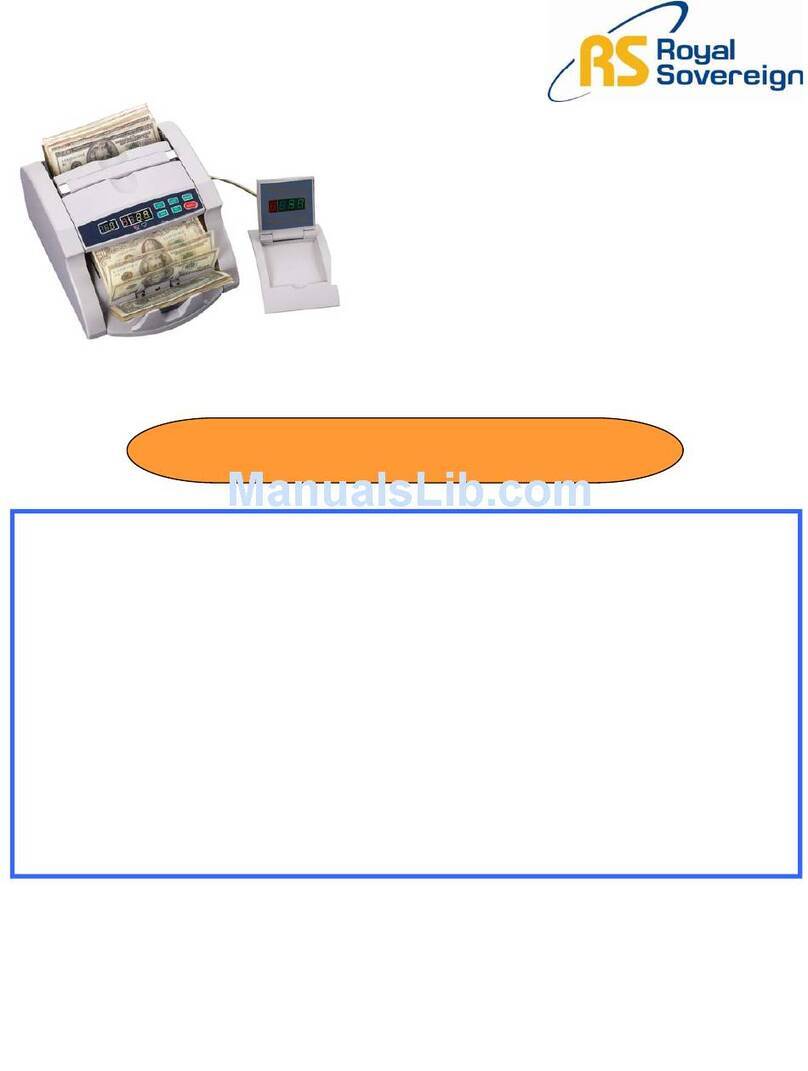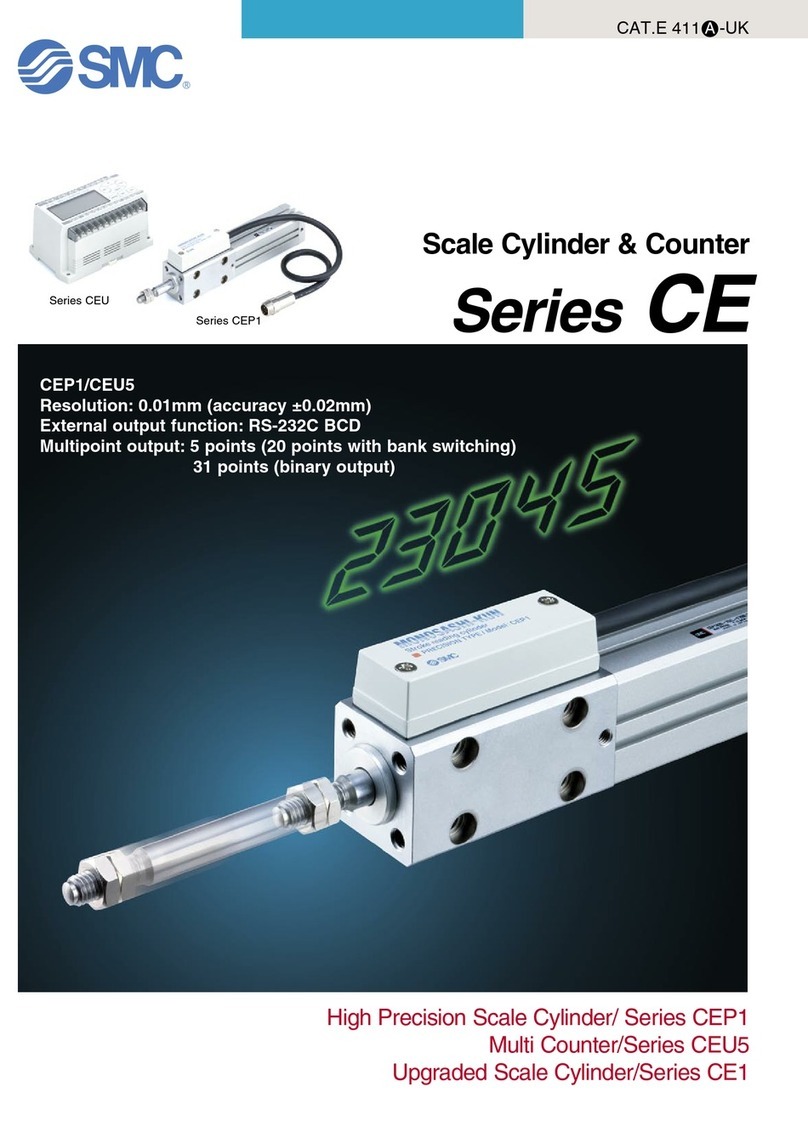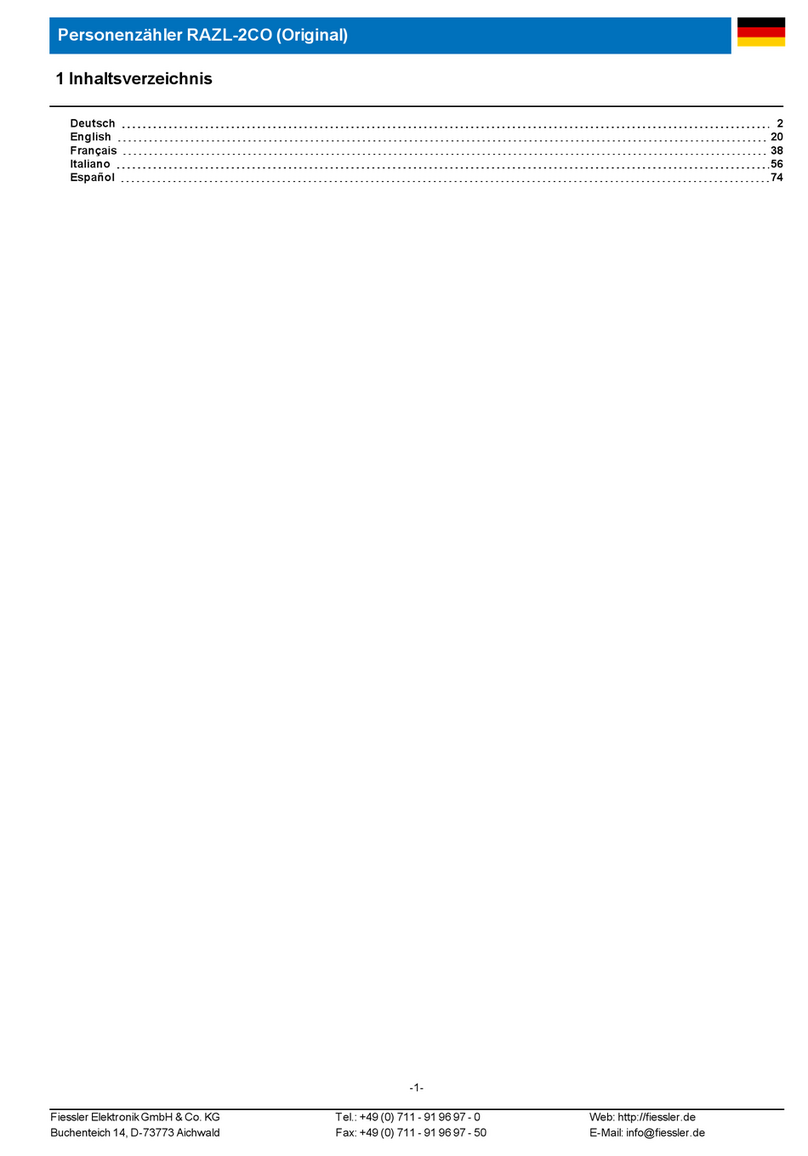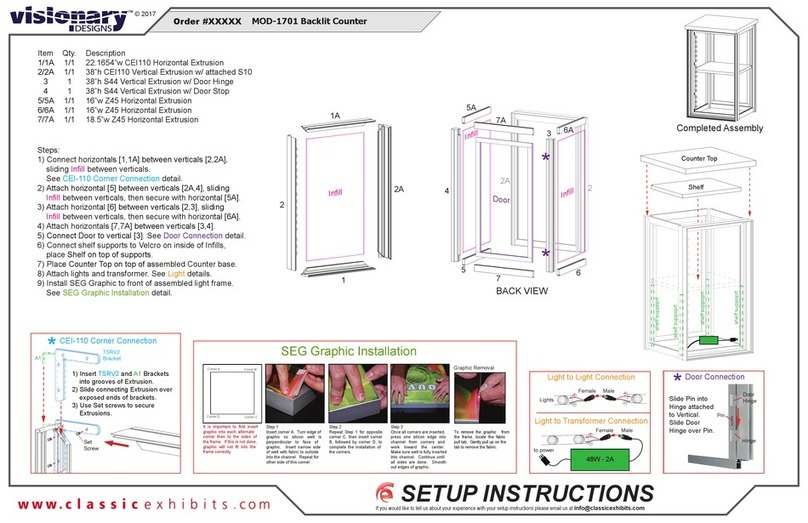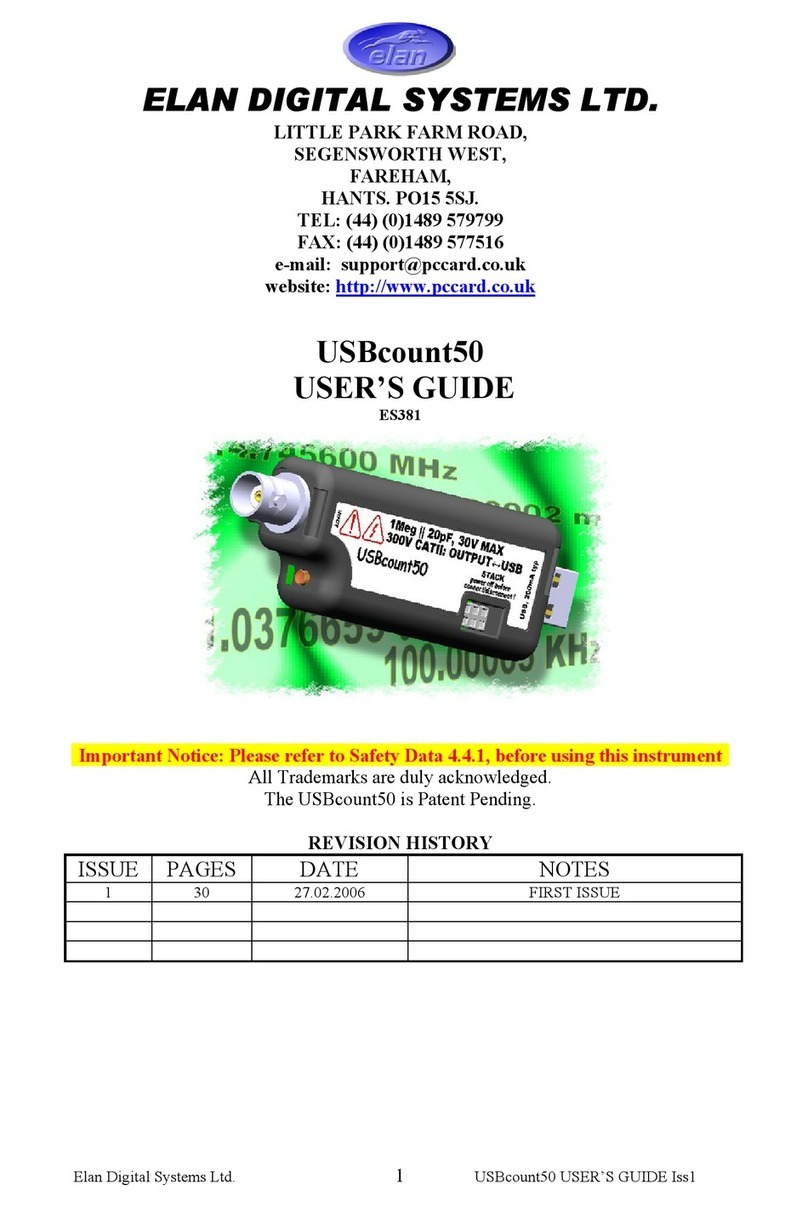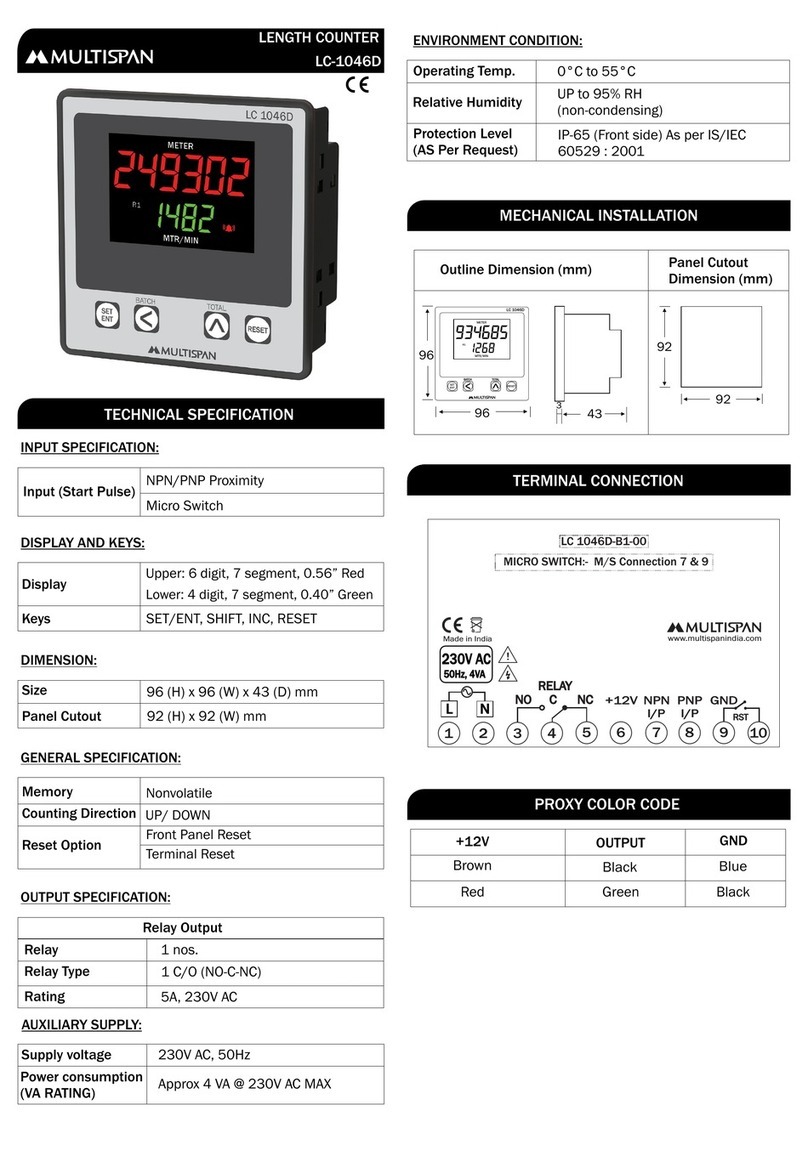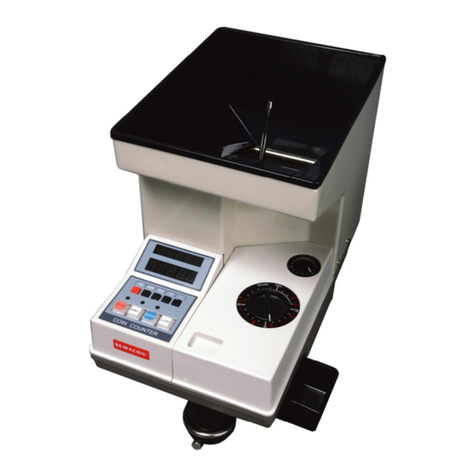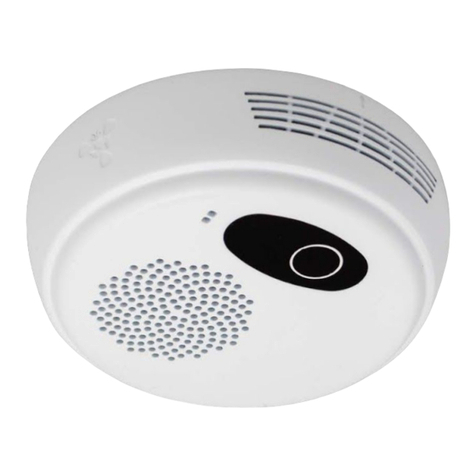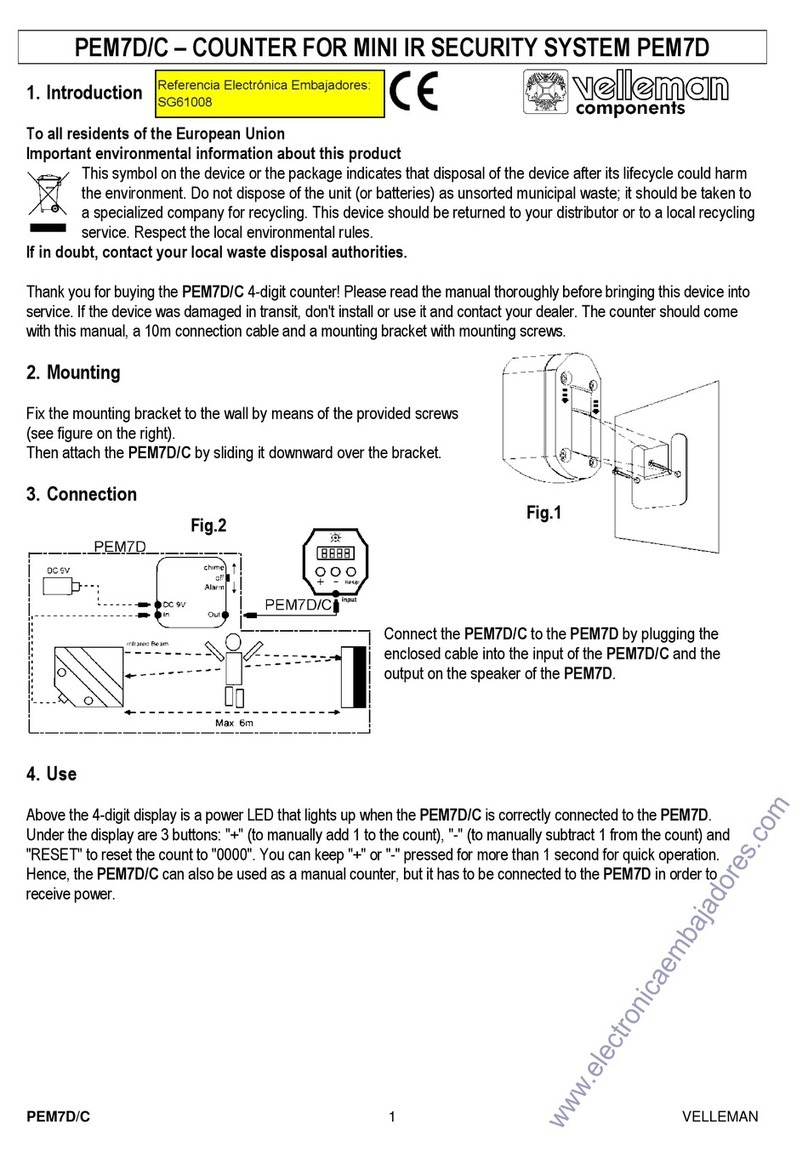EG&G ORTEC 775 Service manual

rsj
^77^
yn
Models
775
and
775H
Counters
I.V»-
j;..;:-
'i--
-.vs"
-■■
■■
■
'

ORTEC
775
COUNTER
Manual
Change
Sheet
April
30,
1974
REV
04
On
schematic
775-0101-Sl
included
at
the
back
of
the
manual,
change
the
reference
designation
for
the
IK
front
panel
Discriminator
control
from
R65
to
R68.
This
is
a
correction
in
the
schematic
only.
March
14,
1975
REV
06
On
the
Replaceable
Parts
List,
page
10,
change
the
listing
for
LED3
to:
LED3
9103
60283
LED,
Numeric
Display,
7-segment
(6
each)
Monsanto
MAN-3M
On
schematic
775-0101-81,
change
the
type
designation
for
LED3
from
TIL360
to
(6
each)
MAN-3M.

Models
775
and
775H
Counters
Operating
and
Service
Manual
This
manual
applies
to
instruments
"Rev
03"
(on
rear
panel)
Printed
in
U.S.A.
Copyright
ORTEC
I
ncorporated
1973
1707
050
0174

STANDARD
WARRANTY
FOR
ORTEC
INSTRUMENTS
ORTEC
warrants
its
instruments
other
than
preamplifier
FET
input
transistors,
vacuum
tubes,
fuses,
and
batteries
to
be
free
from
defects
in
workmanship
and
materials
for
a
period
of
twelve
months
from
date
of
shipment
provided
that
the
equipment
has
been
used
in
a
proper
manner
and
not
subjected
to
abuse.
Repairs
or
replacement,
at
ORTEC
option,
will
be
made
on
in-warranty
instruments,
without
charge,
at
the
ORTEC
factory.
Shipping
expense
will
be
to
the
account
of
the
customer
except
in
cases
of
defects
discovered
upon
initial
operation.
Warranties
of
vacuum
tubes
and
semiconductors
made
by
their
manufacturers
will
be
extended
to
our
customers
only
to
the
extent
of
the
manufacturers'
liability
to
ORTEC.
Specially
selected
vacuum
tubes
or
semiconductors
cannot
be
warranted.
ORTEC
reserves
the
right
to
modify
the
design
of
its
products
without
incurring
responsibility
for
modification
of
previously
manufactured
units.
Since
installation
condi
tions
are
beyond
our
control,
ORTEC
does
not
assume
any
risks
or
liabilities
associated
with
methods
of
instal
lation
or
with
installation
results.
advance
of
its
return.
ORTEC
must
be
informed,
either
in
writing
or
by
telephone
[(615)
482-4411
],
of
the
nature
of
the
fault
of
the
instrument
being
returned
and
of
the
model,
serial,
and
revision
("Rev"
on
rear
panel)
numbers.
Failure
to
do
so
may
cause
unnecessary
delays
in
getting
the
unit
repaired.
Our
standard
procedure
requires
that
instruments
returned
for
repair
pass
the
same
quality
control
tests
that
are
used
for
new-production
instruments.
Instruments
that
are
returned
should
be
packed
so
that
they
will
withstand
normal
transit
handling
and
must
be
shipped
PREPAID
via
Air
Parcel
Post
or
United
Parcel
Service
to
the
nearest
ORTEC
repair
center.
Instruments
being
returned
that
are
damaged
in
transit
due
to
inade
quate
packing
will
be
repaired
at
the
sender's
expense,
and
it
wil
l
be
the
sender's
responsibility
to
make
claim
with
the
shipper.
Instruments
not
in
warranty
will
be
repaired
at
the
standard
charge
unless
they
have
been
grossly
misused
or
mishandled,
in
which
case
the
user
wil
l
be
notified
prior
to
the
repair
being
done.
A
quotation
will
be
sent
with
the
notification.
QUALITY
CONTROL
Before
being
approved
for
shipment,
each
ORTEC
instru
ment
must
pass
a
stringent
set
of
quality
control
tests
designed
to
expose
any
flaws
in
materials
or
workmanship.
Permanent
records
of
these
tests
are
maintained
for
use
in
warranty
repair
and
as
a
source
of
statistical
information
for
design
improvements.
REPAIR
SERVICE
If
it
becomes
necessary
to
return
this
instrument
for
repair,
it
is
essential
that
you
contact
our
Customer
Services
in
DAMAGE
IN
TRANSIT
Shipments
should
be
examined
immediately
upon
receipt
for
evidence
of
external
or
concealed
damage.
The
carrier
making
delivery
should
be
notified
immediately
of
any
such
damage,
since
the
carrier
is
normally
liable
for
damage
in
shipment.
Packing
materials,
waybills,
and
other
such
documentation
should
be
preserved
in
order
to
establish
claims.
After
such
notification
to
the
carrier,
please
notify
ORTEC
of
the
circumstances
so
that
we
may
assist
in
damage
claims
and
in
providing
replacement
equipment
if
necessary.

CONTENTS
Page
WARRANTY
"
PHOTOGRAPHS
'V
1.
DESCRIPTION
1
2.
SPECIFICATIONS
1
2.1.
Performance
^
2.2.
Indicators
"I
2.3.
Controls
1
2.4.
Connectors
1
2.5.
Electrical
and
Mechanical
2
3.
INSTALLATION
2
3.1.
General
2
3.2.
Connection
to
Power
2
3.3.
Signal
Connections
2
4.
OPERATING
INSTRUCTIONS
3
4.1.
Front
Panel
Controls
and
Indicators
3
4.2.
Initial
Operation
of
Counter
3
4.3.
Counting
Setup
with
One
Counter
3
4.4.
Counting
Setup
with
775
and
771
Timer-Counter
4
5.
CIRCUIT
DESCRIPTION
4
5.1.
General
Description
4
5.2.
Pulse
Input
Circuit
4
5.3.
Counting
Decades
4
5.4.
Reset
Circuit
5
5.5.
Internal
Power
Supply
5
6.
MAINTENANCE
5
6.1.
General
5
6.2.
Fuse
Replacement
5
6.3.
Factory
Repair
5
APPENDIX
6
Replaceable
Parts
Schematic
775-0101-S1

"'
y
ORTEC
'
MODEL
775
€
COUNTER
Display
Overflow
Tt-..i
DISCRIMINATOR
4.
i
6
O.IV
lOV
RESET
COUNT
ikfiix
®—
STOP
GATE
./>st
.
"
*'*
.»t'%
/V-
■•
■:.:■:■■
INPUT
:.E!T
<£»
&
IM'llT
liATE
o
I^ESET
vQ.
;)VEI^FL()'.V
o
ci>:w
•'*•••
'*>MO

ORTEC
775
and
776H
COUNTERS
1.
DESCRIPTION
The
ORTEC
775
Counter
is
a
general-purpose
6-decade
sealer
with
an
adjustable
input
discriminator.
It
accepts
and
counts
positive
pulses
if
their
amplitudes
exceed
the
discriminator
threshold
setting,
which
has
a
range
of
100
mV
through
10
V.
The
input
pulse
pair
resolution
is
<50
nsec,
and
the
maximum
counting
rate
is
20
MHz.
The
775
is
packaged
in
a
NIM-standard
single-width
module.
It
includes
all
the
connectors
and
controls
for
either
manual
or
automatic
operation
and
indicates
the
accumulated
count
with
7-segment
l
ight-emitting
diodes
(LED's)
in
a
direct-reading
digital
display.
A
Gate
LED
indicator
l
ights
to
show
when
the
775
is
in
a
counting
condition.
The
gate
is
controlled
by
both
the
manual
Count/Stop
switch
and
the
Gate
signal
input
circuit,
with
connectors
on
both
the
front
and
rear
panels.
If
the
counter
overflows,
this
condition
is
also
shown
by
an
LED
on
the
front
panel;
the
indicator
remains
lit
from
the
first
overflow
until
the
unit
is
reset.
At
each
overflow
an
output
pulse
is
also
furnished
through
a
rear
panel
connector
and
may
be
used
for
connection
into
another
counter
for
an
increased
counting
capacity.
Reset
is
generated
automatical
ly
when
power
is
first
applied
and
can
be
provided
manual
ly
or
by
a
signal
through
a
rear
panel
connector
at
any
time,
whether
the
unit
is
or
is
not
in
a
counting
condition.
The
7-segment
digital
display
can
be
tested
at
any
time
by
pressing
the
Test
switch
on
the
front
panel
.
When
this
switch
is
pressed,
al
l
seven
segments
in
each
digit
should
l
ight
to
provide
a
reading
of
888
888.
The
775H
operates
identically
to
the
775
but
requires
that
the
bin
and
power
supply
in
which
it
is
operated
furnish
+6
V
dc
as
a
power
source.
The
ORTEC
401B/402H
Bin
and
Power
Supply
is
typical
of
the
equipment
required.
2.
SPECIFICATIONS
2.1.
PERFORMANCE
Count
Capacity
6
decades,
for
000
000
through
999
999.
Counting
Rate
20
MHz
guaranteed.
Input
Discriminator
Adjustable
through
range
of
+0.1
to
+10
V;
drift
<0.01%
of
ful
l
scale/°C,
0
to
+50°C.
Automatic
Clear
Generated
when
power
is
turned
on
initial
ly
or
after
a
power
fai
lure.
2.2.
INDICATORS
Readout
Display
6
direct-reading
7-segment
LED
digits.
Overflow
LED
il
luminated
from
first
overflow
unti
l
reset.
Gate
LED
il
luminated
whi
le
unit
is
in
the
counting
condition.
2.3.
CONTROLS
Display
Test
Push-button
switch
l
ights
al
l
7
segments
of
each
digit
in
the
display
when
it
is
pressed
for
a
reading
of
Discriminator
Single-turn
potentiometer
sets
the
discrimi
nation
level
for
the
positive
input
signal
from
100
mV
to
10
V.
Reset
Push-button
switch
resets
display
and
internal
logic
to
an
initial
condition
when
pressed.
Count/Stop
Toggle
switch
selects
counting
or
noncounting
condition
of
the
unit
manual
ly.
2.4.
CONNECTORS
Input
Front
and
rear
panel
type
BNC
connectors
accept
positive
unipolar
or
bipolar
signals
to
±25
V
maximum.
Input
ampl
itude
must
exceed
adjusted
threshold
level
for

20
nsec
minimum
to
be
counted.
Zjp
1
kS2
to
ground,
dc-coupled.
Gate
Front
and
rear
panel
type
BNC
connectors
accept
standard
positive
logic
signal
to
control
the
counter
gate
and
the
associated
indicator.
Open
circuit
or
>+3
V
to
al
low
counting;
<+1.5
V
to
inhibit
counting;
25
V
maximum;
driving
source
must
be
capable
of
sinking
0.5
mA
of
positive
current.
Reset
Rear
panel
type
BNC
connector
accepts
standard
positive
logic
pulse
to
reset
the
unit
to
an
initial
zero
condition.
>+3
V
resets;
<+1.5
V
does
not
reset;
25
V
maximum;
100
nsec
width
minimum.
2
kfi
dc-coupled
to
ground.
Overflow
Rear
panel
type
BNC
connector
furnishes
stand
ard
positive
logic
output,
+5
V
for
2
/tisec,
whenever
the
counter
overflows
from
999
999
to
0.
Driving
source
impedance
<1
Of2
dc-coupled.
2.5.
ELECTRICAL
AND
MECHANICAL
Power
Required
For
the
775
Counter:
+25
V,
95
mA;
—1
2
V,
20
mA;
11
5
V
ac,
50
mA,
50
or
60
Hz.
For
the
775
H
Counter:
+
12
V,
95
mA;
—12
V,
20
mA;
+6
V,
550
mA.
Dimensions
Standard
NIM
single-width
module
(1.35
by
8.714
in.)
per
TID-20893.
3.
INSTALLATION
3.1.
GENERAL
3.3.
SIGNAL
CONNECTIONS
The
775
operates
on
input
power
that
must
be
furnished
from
a
Nuclear-standard
Bin
and
Power
Supply
such
as
the
ORTEC
401/402
Series.
If
any
vacuum
tube
equipment
is
operated
in
the
same
rack
with
the
775,
there
must
be
sufficient
cool
ing
air
circulating
to
prevent
any
local
ized
heating
of
the
integrated
circuitry
used
throughout
the
775.
The
temperature
of
equipment
mounted
in
racks
can
easi
ly
exceed
the
maximum
l
imits
of
120°F
(50
C)
unless
precautions
are
taken.
3.2.
CONNECTION
TO
POWER
Turn
off
the
Bin
Power
Supply
when
inserting
or
removing
any
modules.
The
ORTEC
modules
are
designed
so
that
it
is
not
possible
to
overload
the
Power
Supply
with
even
a
ful
l
complement
of
modules
in
the
Bin.
Since,
however,
this
may
not
be
true
when
the
Bin
contains
modules
other
than
those
of
ORTEC
design,
the
Power
Supply
voltages
should
be
checked
after
al
l
modules
have
been
inserted.
The
401/402
has
test
points
on
the
Power
Supply
control
panel
to
permit
monitoring
the
dc
voltages
easi
ly.
The
775
requires
11
5
V
ac
as
one
of
its
power
inputs.
Some
bins
and
power
suppl
ies,
as
wel
l
as
jumper
cables,
may
not
be
wired
to
include
this
power.
In
the
event
that
the
unit
fai
ls
to
operate
in
a
new
instal
lation,
check
the
bin
and/or
cable
to
determine
whether
the
11
5-V
ac
circuit
is
included.
The
775H
version
requires
+6
V
at
550
mA.
It
must
be
used
with
an
ORTEC
401
B/402H
Bin
and
Power
Supply
or
equivalent
to
satisfy
this
power
requirement.
No
ac
power
is
required
for
the
775H.
Count
Input
The
signal
to
be
counted
by
the
775
can
be
connected
to
either
the
front
or
rear
panel
BNC
connector.
These
two
connectors
are
not
isolated
from
each
other;
signals
from
two
sources
should
not
be
used
and
connected
simultaneously
to
the
two
input
connectors.
The
input
circuit
of
the
775
is
dc-coupled
to
eliminate
basel
ine
shifts
associated
with
changing
counting
rates.
For
signals
whose
average
dc
level
is
greater
than
±25
V,
external
capacitive
coupl
ing
must
be
provided
by
the
user.
For
dc
levels
below
25
V,
connection
can
be
made
to
the
input
safely
without
damage
to
the
775.
However,
for
the
sealer
to
count
these
signals
there
must
be
transitions
of
the
signals
within
the
range
of
0.1
to
10
V,
since
this
is
the
input
range
over
which
the
discriminator
operates.
The
flexibi
l
ity
of
the
775
makes
it
possible
to
count
almost
any
signal
wider
than
20
nsec
and
greater
than
100
mV
in
ampl
itude.
There
are
two
important
points
to
remember
when
supplying
signals
to
the
input:
(1)
The
signal
should
not
cross
the
threshold
level
more
than
one
time.
Signals
with
overshoot,
ringing,
etc.
,
wi
l
l
be
counted
more
than
once
if
the
discriminator
level
is
raised
to
the
level
at
which
the
perturbations
occur.
(2)
Signals
with
slow
rise
and
fall
times
should
be
as
clean
(noise-free)
as
possible
because
of
the
high
gain
and
bandwidth
of
the
775
discriminator.
As
a
slow
signal
approaches
the
threshold,
a
smal
l
spurious
noise
pulse
can
traverse
the
threshold
and
return,
causing
an
extra
count
to
be
added
to
the
contents
of
the
sealer.
Gate
Input
The
Gate
input
signal
can
be
connected
to
the
775
by
either
the
front
or
rear
panel
BNC
connector.
As
in

the
case
of
the
count
input
connectors,
no
isolation
is
provided
between
the
two
inputs;
so
two
signal
sources
should
not
be
connected
simultaneously.
When
there
is
no
connection
to
the
Gate
input,
the
sealer
gate
permits
the
unit
to
operate.
To
cut
the
gate
off,
the
gate
input
must
be
pul
led
down
below
+1.5
V
but
not
below
—5
V.
To
do
this,
the
driving
circuit
must
be
capable
of
absorbing
0.5
mA
from
the
gate
input
circuit.
The
gate
input
circuit
permits
counting
when
the
gate
input
is
at
+3
V
or
greater.
Reset
Input
A
reset
input
signal
can
be
connected
to
the
775
through
the
rear
panel
BNC
connector.
To
reset
the
sealer
to
zero,
a
positive
signal
of
+3
V
or
greater
originating
from
zero
potential
with
a
minimum
width
of
100
nsec
should
be
used.
The
input
impedance
is
approxi
mately
2
kfZ
dc-coupled
to
ground.
Negative
signals
will
not
perform
any
useful
function
at
the
reset
input.
The
input
circuitry
wi
ll
not
be
harmed
as
long
as
the
input
signal
level
does
not
exceed
±25
V.
Overflow
Output
The
overflow
signal
is
available
through
a
rear
panel
BNC
connector.
A
positive
5-V
signal
appears
at
the
output
each
time
the
contents
of
the
counter
change
from
999999
to
zero.
The
output
signal
width
is
2
/jsec.
Zq
<
10Tl,
dc-coupled.
4.
OPERATING
INSTRUCTIONS
4.1.
FRONT
PANEL
CONTROLS
AND
INDICATORS
The
following
functions
are
indicated
and
controllable
from
the
front
panel
:
Count/Stop
Manual
ly
controls
counting
of
the
775;
Count
position
permits
counting
and
Stop
position
inhibits
counting.
Gate
Indicator
An
LED
indicates
the
condition
of
the
input
gate.
When
it
glows,
the
775
is
able
to
count
input
pulses.
When
it
is
dark,
the
775
is
inhibited
from
counting.
Reset
A
push-button
switch
resets
the
contents
of
the
counter
to
zero
when
it
is
depressed.
Discriminator
A
single-turn
potentiometer
selects
the
threshold
level
of
the
internal
discriminator
with
a
range
of
100
mV
through
10
V.
Normally,
for
counting
logic
signals,
the
level
should
be
adjusted
about
half
way
between
the
lowest
expected
true
signal
amplitude
and
the
maximum
false
signal
amplitude.
For
use
with
l
inear
signals
assure
that
the
signals
have
only
one
point
of
inflection,
or
some
signals
may
cross
the
threshold
more
than
one
time
and
produce
erroneous
results.
Overflow
Indicator
An
LED
l
ights
if
the
counter
capacity
of
999
999
counts
is
exceeded,
and
remains
l
ighted
unti
l
the
unit
is
reset.
Display
Test
A
push-button
switch
permits
a
quick
check
of
the
digital
display.
When
it
is
pressed,
all
seven
segments
of
each
of
the
six
digits
wi
l l
be
lighted,
regardless
of
the
counter
contents,
and
the
display
wi
ll
read
al
l
"eights."
Digital
Display
Six
7-segment
characters
with
logically
selected
blanking
for
each
segment
display
the
counter
contents
at
all
times
except
during
the
Display
Test
interval.
Each
character
can
display
a
digit
from
0
through
9.
4.2.
INITIAL
OPERATION
OF
COUNTER
1.
Install
the
775
into
a
401/402
Series
Bin
and
Power
Supply
or
equivalent
and
turn
on
the
power.
2.
Press
Reset.
The
display
should
now
indicate
that
the
contents
of
the
counter
are
zero.
3.
Press
Display
Test.
The
display
should
read
and
should
return
to
0
when
the
switch
is
released
4.
Set
the
Count/Stop
switch
at
Count,
and
the
Gate
indicator
should
light.
Set
the
switch
at
Stop,
and
the
light
should
go
out.
5.
Connect
a
signal
to
the
Input
connector.
6.
Set
the
Count/Stop
switch
at
Count.
7.
Turn
the
Discriminator
control
counterclockwise
unti
l
the
775
starts
to
count.
8.
Ground
the
Gate
input
and
observe
that
counting
stops
and
that
the
indicator
LED
is
not
l
ighted.
Remove
the
ground
and
restore
the
counting
condition.
9.
Set
the
Count/Stop
switch
at
Stop,
and
counting
should
stop
and
the
indicator
again
not
be
l
ighted.
4.3.
COUNTING
SETUP
WITH
ONE
COUNTER
Proceed
as
outl
ined
in
Section
4.2
but
omit
those
steps
used
in
"testing"
the
instrument.
Be
sure
that
the
input
signals
do
not
exceed
the
±25-V
maximum
limits.

4.4.
COUNTING
SETUP
WITH
775
AND
771
TIMER-COUNTER
An
ORTEC
771
Timer-Counter
can
be
used
to
control
the
time
in
a
counting
interval
whi
le
input
pulses
are
being
counted
in
the
775.
The
setup
Is
made
by
connecting
a
cable
from
the
Interval
output
BNC
on
the
rear
panel
of
the
771
to
the
Gate
Input
on
either
the
front
or
rear
panel
of
the
775.
This
interconnection
wil
l
al
low
the
775
to
accumulate
input
counts
only
during
the
interval
when
the
771
is
counting
time.
Use
theTol
lowIng
procedure:
1.
On
the
775
set
the
Count/Stop
switch
at
Count.
2.
With
no
Gate
input
connection
and
with
the
light
indicating
that
the
775
is
in
a
counting
condition,
check
to
see
that
Input
pulses
are
able
to
be
counted.
Readjust
the
Discriminator
level
if
necessary.
3.
Set
the
Count/Stop
switch
at
Stop
and
press
Reset.
4.
Connect
the
Gate
input
cable
from
the
771
Interval
output
to
the
775
Gate
input.
5.
On
the
771
set
the
Count/Stop
switch
at
Stop.
6.
On
the
775
set
the
Count/Stop
switch
at
Count.
7.
The
instruments
are
ready
to
be
used.
When
the
counting
interval
is
to
be
started,
set
the
771
Count/Stop
switch
at
Count,
and
both
modules
should
be
in
a
counting
condition.
At
the
end
of
the
selected
time
Interval
on
the
771,
preset
stop
wil
l
affect
both
modules.
To
stop
the
counting
interval
manual
ly,
use
the
Count/Stop
switch
on
the
771
and
read
the
time
for
the
interval
on
the
771.
If
In
the
setup
just
described
the
771
Timer-Counter
had
been
operated
as
a
counter,
the
775
data
would
have
represented
the
number
of
counts
above
its
threshold
per
N
(preset
condition)
counts
from
another
source
Into
the
771.
The
ratio
of
two
counting
rates
can
be
determined
in
this
manner.
5.
CIRCUIT
DESCRIPTION
5.1.
GENERAL
DESCRIPTION
The
ORTEC
775
Counter
is
a
6-decade
ripple
sealer
preceded
by
a
precise
l
inear
discriminator
and
includes
logic
for
gating.
An
internal
osci
l
lator
drives
a
7-state
ring
scanner
with
a
BCD-to-decimal
decoder
to
control
the
6-diglt
LED
display.
See
schematic
775-010TS1
at
the
back
of
the
manual
for
circuit
detai
ls.
5.2.
PULSE
INPUT
CIRCUIT
Input
signals
in
the
range
of
0.1
through
10
V
can
be
applied
through
either
the
front
or
rear
panel
BNC
Input
connector.
They
are
dc-coupled
through
divider
R41
and
R42
to
the
positive
input
of
comparator
IC
24.
The
negative
Input
to
IC
24
is
the
dc
level
selected
with
Discriminator
control
R65
on
the
front
panel
.
Each
input
pulse
whose
amplitude
exceeds
the
discrimination
level
wi
l l
generate
a
logic
output
from
IC
24-7
to
drive
IC
9-8.
If
the
775
is
not
being
reset
and
its
Gate
indicator
l
ight
is
l
ighted,
the
Input
pulse
becomes
a
clock
pulse
into
the
least
significant
decade,
IC
10,
and
Is
counted.
With
no
Gate
input
signal
and
with
switch
S3
set
at
Count,
IC
19-6
is
high
and
IC
20-8
is
low,
making
IC
19-11
high
and
permitting
IC
9-6
to
pass
the
Input
pulse.
If
the
switch
is
set
at
Stop,
IC
20-8
goes
high
and
the
gate
is
inhibiting.
Likewise,
If
there
is
a
Gate
input
connection
and
the
signal
is
dropped
to
<+1.5
V,
IC
20-8
goes
high
and
the
gate
Is
inhibited.
One
of
the
functions
of
IC
19-11
is
to
drive
the
input
to
IC
20-1
2
and
l
ight
LED
1
when
the
gate
is
enabled.
During
the
interval
of
a
reset
signal,
IC
21-11
goes
low
and
this
drives
IC
20-12
high
and
turns
off
LED
1
;
any
input
during
this
interval
wil
l
not
be
counted
because
IC
19-3
is
low
and
gate
IC
9-6
inhibits
the
Input
pulse.
5.3.
COUNTING
DECADES
The
type
7490
circuits,
IC
10
through
IC
15,
are
the
counting
decades.
The
gated
Input
pulses
are
used
as
clock
input
pulses
to
IC
10,
and
the
overflow
from
each
of
the
decades
Is
the
clock
pulse
for
the
next
more
significant
decade.
The
overflow
output
from
IC
15
triggers
fl
ip-flop
IC
22-11
and
IC
22-8
to
l
ight
LED
2
unti
l
the
next
reset.
The
same
pulse
is
shaped
for
an
Overflow
output
signal
through
CN6
by
monostable
Q16
and
IC
23-8
and
emitter-fol
lower
017.
If
there
is
more
than
one
overflow,
each
overflow
wil
l
generate
an
output
pulse.
The
1-2-4-8
BCD
state
of
each
decade
is
avai
lable
through
four
output
lines.
The
states
of
all
four
output
l
ines
for
each
decade
are
gated
onto
common
l
ines
through
IC
1
to
IC
6.
Gating
is
control
led
by
a
ring
scanner,
and
the
coded
combination
for
each
digit
Is
gated
onto
the
common
l
ines
individual
ly
and
sequential
ly.
Osci
l
lator
IC
23-2
and
IC
23-4
is
a
free-running
multi
vibrator
with
a
period
of
about
1
msec.
Its
output
is
used
to
drive
the
clock
Input
of
decade
counter
IC
16.
The
BCD
output
from
IC
16
is
decoded
to
decimal
numbers
in
IC
8,
and
each
of
the
decoded
states
0
through
5
enables
the
gate
for
a
selected
decade
and
enables
the
comparable
character

in
LED
3
to
display
that
digit.
When
IC
16
is
advanced
to
a
state
of
6,
the
decade
is
reset
to
zero
through
IC
22-3
and
IC
22-6
to
start
the
scan
again.
The
four
common
l
ines
wi
l l
carry
the
BCD
identification
for
the
selected
decade
into
IC
17,
which
decodes
the
digit
for
the
7-segment
LED
3
character
that
is
enabled
by
the
selection
of
IC
8.
When
al
l
seven
segments
of
a
character
are
lighted,
a
digit
8
is
formed
in
the
display.
Selective
blanking
of
the
segments
a
through
g
forms
any
of
the
other
9
digits.
Segment
a
is
across
the
top
of
the
character,
with
segments
b
through
f
clockwise
around
the
border
and
segment
g
across
the
center.
When
switch
SI
is
pressed,
al
l
seven
segments
of
al
l
characters
are
lighted
for
a
test
of
the
display.
IC
21-3
and
IC
21-6
provide
blanking
for
insignifi
cant
zeros
in
the
display.
(Local
Reset)
signal
resets
all
counting
decades
to
zero,
restores
the
fl
ip-flop
for
LED
2
if
it
had
been
set
during
the
prior
counting
interval,
inhibits
acceptance
of
any
input
pulses
and
turns
off
LED
1
through
IC
20-12,
and
inhibits
the
generation
of
an
Overflow
output
pulse
by
the
response
through
IC
23-6.
5.5.
INTERNAL
POWER
SUPPLY
An
internal
power
supply
is
included
to
generate
the
+5-V
source
for
the
integrated
circuits.
115
V
ac
is
appl
ied
to
T1
and
ful
l-wave-rectified
by
D4,
fi
ltered
by
C18
and
C19,
and
regulated
by
Q18
through
Q20.
Fuse
F1,
1.5
A,
is
mounted
in
a
fuseholder
on
the
printed
circuit
board.
The
fuse
protects
the
+5-V
source
from
overloads
due
to
shorts
in
the
instrument.
5.4.
RESET
CIRCUIT
The
775
can
be
reset
at
any
time
by
either
pressing
switch
S2
on
the
front
panel
or
by
furnishing
a
reset
input
pulse
through
CN5
on
the
rear
panel
.
Either
of
these
conditions
makes
IC
20-6
go
high
during
the
reset
signal.
The
LR
The
775H
Counter
does
not
contain
the
portion
of
this
power
supply
that
consists
of
T1,
D4,
C18,
and
C19.
It
obtains
its
+5-V
power
from
the
+6-V
source
in
the
ORTEC
401
B/402FI
Bin
and
Power
Supply.
In
this
version
the
collector
of
Q20
is
connected
to
pin
10
of
the
rear
panel
module
power
connector.
6.
MAIIMTEIMANCE
6.1.
GENERAL
The
basic
performance
of
the
775
Counter
can
be
tested
by
following
the
procedure
outl
ined
In
Section
4.2.
This
wil
l
not
check
the
unit
to
its
publ
ished
specifications.
If
the
unit
fails
to
respond
properly
during
testing,
use
the
information
in
Section
5
to
determine
the
fault.
Schematic
775-0101-S1
at
the
back
of
the
manual
includes
al
l
the
circuits
in
the
unit.
6.2.
FUSE
REPLACEMENT
If
the
front
panel
display
and
indicators
cannot
be
lighted,
remove
the
left
side
panel
and
inspect
fuse
F1.
This
fuse
protects
the
+5-V
power
source
that
is
used
for
al
l
the
integrated
circuits
in
the
instrument,
and
the
Indicators
cannot
be
lit
unless
the
Integrated
circuits
are
operating.
Replace
the
fuse
with
a
type
SAG
fuse
with
a
1.5-A
rating
only.
6.3.
FACTORY
REPAIR
The
775
can
be
returned
to
ORTEC
for
repair
service
at
a
nominal
cost.
Our
standard
procedure
requires
that
each
repaired
instrument
receive
the
same
extensive
qual
ity
control
tests
that
a
new
instrument
receives.
Please
contact
our
Customer
Service
Department
at
(615)
482-4411
for
shipping
instructions
before
returning
the
instrument.

APPENDIX
REPLACEABLE
PARTS
ORDERING
INFORMATION
The
Replaceable
Parts
List
shown
below
contains
informa
tion
needed
for
ordering
spare
and/or
replacement
parts.
Each
listing
indicates
the
reference
designator
number,
the
part
number,
a
description
of
the
component,
and
the
part
manufacturer
and
manufacturer's
part
number.
All
inquiries
concerning
spare
and/or
replacement
parts
and
all
orders
for
same
should
include
the
model
serial,
and
revision
("Rev"
on
rear
panel)
numbers
of
the
instruments
involved
and
should
be
addressed
to
the
Customer
Service
Department
at
100
Midland
Road,
Oak
Ridge,
Tennessee
37830.
The
Manager
of
Customer
Services
can
be
reached
by
telephone
at
(615)
482-4411.
The
minimum
order
for
spare
and/or
replacement
parts
is
$25.00.
ORDERING
INFORMATION
FOR
PARTS
NOT
LISTED
In
order
to
facilitate
the
ordering
of
a
part
not
listed
below,
the
following
information
should
be
submitted
to
the
Customer
Service
Department:
1.
the
instrument
model
number,
2.
the
instrument
serial
number,
3.
revision
("Rev"
on
rear
panel)
number,
4.
a
description
of
the
part,
5.
information
as
to
the
function
and
location
of
the
part.
The
solid-state-device
(diodes,
transistors,
and
integrated
circuits)
types
installed
in
your
instrument
may
differ
from
those
shown
in
the
schematic
diagram
and
parts
l
ist.
In
such
cases,
necessary
replace
ments
can
be
made
with
either
the
type
shown
or
the
type
actual
ly
installed
in
the
instrument.
Replaceable
Parts
List
RtFERENCE
DESIGNATOR
ORTEC
PART
NO
DESCRIPTION
MFR.
MFR
PART
NO
775-0100
5OOI4
^46193
CR1
9097
41339
ConiKctor.
BNC.
UG1094/U
95712
DCE
cm
9097
41339
Connector,
BNC,
UG1094/U
95712
DGE
cm
9097
41339
Connector,
BNC,
UC1094/U
95712
DCE
CM
9097
41339
Connector,
BNC,
UC1094/U
95712
DGE
CK
9097
41339
Connector,
BNC,
UC1094/U
95712
DCE
CN6
9097
41339
Connector,
BNC,
UG1094/U
95712
DCE
K65
9091
40801
IK
3W
57,
Pot.
44655
OHM
#RV4NAYSiPl02A
(MIL)
SI
9094
41293
Switch,
P-B,
SPOT
(Red)
82389
sue
S2
9094
41293
Switch,
P-B,
SPOT
(Red)
82389
sue
#953
S3
9094
41277
Swtich,
Toggle,
SPDT
95146
AEP
#MST-105D
LEDl
9103
63798
LED
Indicator
W/Mount
72619
DIL
#521-9166
LBD2
9103
63798
LED
Indicator
W/Mount
72619
DIL
#521-9166

Replaceable
Parts
List
(continued)
REFERENCE
DESIGNATOR
ORTEC
PART
NO
DESCRIPTION
MFR.
MFR.
PART
NO.
775-0100-1
500ii
'♦6196
Cl8
9067
147378
2200
uf
25V
El,
FRAKO
FRAKO
#B1735/2200/25(70)
C19
9067
147378
2200
uf
25V
El.
FRAKO
FRAKO
#B1735/2200/25(70)
Dlt
9080
1414206
F.W.
Bridge
27777
VRO
#VH2l47
T1
9090
61173
Transformer
07119
KMC
#T-11*97
775-0200
5007
I4619I4
C1
90^9
I4O889
200
nf
500V
2%
D.M.
81*171
ARC
#DM1
5-201
G
C2
9059
I4O892
1*70
pf
5OOV
57o
D.M.
8I4I71
ARC
#DM15-l471J
C3
9065
I4O9I42
1
uf
35V
20%
Tan.
80183
SPR
#1500105X0035A2
Ck
9065
I4O9I42
1
uf
35V
20%
Tan.
80183
SPR
#1500105X0035A2
C5
9055
I4O855
0.01
uf
5OV
20%
Disc.
80183
SPR
#C023K101F103M
C6
9055
140855
0.01
uf
5OV
20%
Disc.
80183
SPR
#C023K101F103M
C7
9065
14951+2
6.8
uf
35V
20%
Tan.
12951+
DCK
#d68r8g5B35M
C8
9055
I4O855
0.01
uf
5OV
20%
Disc.
80183
SPR
#C023K101F103M
C9
9055
I4O855
0.01
uf
5OV
20%
Disc.
80183
SPR
#C023K101F103M
CIO
9065
I4O953
220
uf
10V
20%
Tan.
80183
SPR
#1500227X00152
C11
9065
I4O9I48
6.8
uf
35V
20%
Tan.
80183
SPR
#1500685x003562
C12
9065
1409148
6.8
uf
35V
20%
Tan.
80183
SPR
#1500685x003502
C13
9055
I4O855
0,01
uf
5OV
20%
Disc.
80183
SPR
#C023K101F103M
CII4
9055
I4O855
0.01
uf
5OV
20%
Disc.
80183
SPR
#C023K101F103M
C15
9055
1*0855
0.01
uf
5OV
20%
Disc.
80183
SPR
#C023K101F103M
CI6
9055
I4O855
0
01
uf
5OV
20%
Disc.
80183
Sm
#C023K101F103M
CI7
9055
1+0855
0.01
uf
5OV
20%
Disc.
80183
SPR
#C023K101F103M
C20
9059
40886
100
pf
500V
2%
DM
84171
ARC
#DM15-101G
D1
9080
1(1125
Diode
-
INI4OO9
11+1433
ITT
D2
9080
I4II25
Diode
—
1N1|009
11*1*33
ITT
D3
9080
I4II25
Diode
-
1Nlt009
11+1+33
ITT
F1
9101
I4I7I+7
Fuse,
1
.5
Amp,
250V
75915
LIT
#312001
.5
IC-1
9079
I4I4O83
IC
-
SN7I4O3N
270II4
NSC
IC-2
9079
I4I+O83
IC
-
SN7I4O3K
27011*
NSC
IC-3
9079
1+1*083
IC
-
SN7I4O3N
27011*
NSC
IC-ir
9079
I4I4O83
IC
-
SN7I4O3N
27OII4
NSC
ic-5
9079
I4I4O83
IC
-
SN7I4O3N
27OII4
NSC
ic-6
9079
1+1+083
IC
-
SN7I4O3N
27OII4
NSC
lc-7
9079
1+1+079
IC
-
SN7l401*N
27OII4
NSC
ic-8
9079
1+91+95
IC
-
SN71+I42N
27OII4
NSC
lc-9
9079
1+1+081
IC
-
SN7I4ION
27011*
NSC

Replaceable
Parts
List
(continued)
REFERENCE
DESIGNATOR
ORTEC
PART
NO
DESCRIPTION
MFR.
MFR.
PART
NO
775-0200
5007
hSTSk
cont'd.
IC-10
9079
ltlt072
IC
-
SN7490N
27014
NSC
IC-1
1
9079
44072
IC
-
SN7490N
27014
NSC
IC-12
9079
44072
IC
-
SN7490N
27014
NSC
IC-1
3
9079
44072
IC
-
SN7490N
27014
NSC
IC-1/4
9079
44072
IC
-
SN749ON
27014
NSC
IC-1
5
9079
44072
IC
-
SN7490N
27014
NSC
IC-1
6
9079
44072
IC
-
SN7490N
27014
NSC
IC-1
7
9079
66152
IC
-
SN7448N
01295
TI
IC-1
8
9079
44079
IC
-
SN7404N
27014
NSC
IC-1
9
9079
44073
IC
-
SN7400N
27014
NSC
IC-20
9079
44081
IC
-
SN7410N
27014
NSC
IC-21
9079
44073
IC
-
SN7400N
27014
NSC
IC-22
9079
44073
IC
-
SN7400N
27014
NSC
IC-23
9079
44082
IC
-
SN7405N
27014
NSC
IC-24
9079
41815
IC
-
710
13715
Fsc
#U5B771039X
Q1
9078
43655
Transistor
-
MPS6531
80211
MOT
Q2
9078
43655
Transistor
-
MPS6531
80211
MOT
Q3
9078
43655
Transistor
-
HPS653I
80211
MOT
Oh
9078
43655
Transistor
-
M?S65JT
80211
MOT
05
9078
43655
Transistor
-
MPS6531
§021
1
MOT
06
9078
43655
Transistor
-
MPS6531
80211
MOT
07
9078
43655
Transistor
-
MPS653I
80211
MOT
q6
9078
43655
Transistor
-
MPS6531
80211
MOT
09
9078
43655
Transistor
-
MPS6531
80211
MOT
QIC
9078
43655
Transistor
i-
MPS6531
80211
MOT
Oil
9078
43655
Transistor
-
MPS6531
80211
MOT
012
9078
43655
Transistor
-
MPS653I
80211
MOT
013
9078
43655
Transistor
-
MPS6531
80211
MOT
01
If
9078
43655
Transistor
-
MPS6531
80211
MOT
015
9078
43655
Transistor
-
MPS653I
80211
MOT
016
9078
43651
Transistor
-
MPS3646
80211
MOT
017
9078
43655
Transistor
-
MPS6531
80211
MOT
018
9078
41083
Transistor
-
2N3643
13715
FSC
019
9078
41070
Transistor
-
2N3053
86684
RCA
020
9078
43682
Transistor
-
MJE3055
80211
MOT
Q21
9078
43655
Transistor
-
MPS653I
80211
MOT
R1
9015
40269
180
n
1/4W
5%
C
01121
ABC
CB
R2
9015
40233
2.4
K
1/4W
5%
C
01121
ABC
CB
R3
9015
40269
180
n
1
/4w
57o
C
01121
ABC
CB
Rlt
9015
40233
2.4
K
1
/4W
57o
C
01121
ABC
CB
R5
9015
40269
180
f?
1
/4W
57o
C
01121
ABC
CB
r6
q015
40233
2.4
K
1/4W
5%
C
01121
ABC
CB
R7
9015
40269
180
n
1/4W
5%
C
01121
ABC
CB

Replaceable
Parts
List
(continued)
REFERENCE
DESIGNATOR
ORTEC
PART
NO
DESCRIPTION
MFR
MFR
PART
NO
775-0200
5007
^♦619^
cont'd.
R8
9015
40233
2.4
K
1
/4W
5%
c
01
121
ABC
CB
R9
9015
40269
180
n
1
/4w
57o
c
01
121
ABC
CB
RIO
9015
40233
2.4
K
1
/4w
5%
c
01121
ABC
CB
R11
9015
40269
180
n
1
/4w
57o
c
01121
ABC
CB
aia
9015
40233
2.4
K
1
/4W
5%
c
011
21
ABC
CB
9015
40269
180
f?
1
/4w
57v
c
01121
ABC
CB
Hlk
9015
40233
2.4
K
1
/4W
57o
c
01121
ABC
CB
ni5
9015
40233
2.4
K
1
/4W
5%
c
01121
ABC
CB
wt
9015
40287
1
.3
K
1
/4W
5%
c
01121
ABC
CB
117
9015
40233
2.4
K
1
/4W
57c
c
01121
ABC
CB
tl8
9015
40287
1
.3
K
1
/4W
57c
c
01121
ABC
CB
119
9015
40233
2.4
K
1
/4W
57c
c
01121
ABC
CB
RM
9015
40287
1.3
K
1
/4W
5'?(;
c
01121
ABC
CB
m
9015
40233
2.4
K
1/4J|(
57c
c
01121
ABC
CB
n
n
9015
40287
1
.
3
K
1
/4w
57o
c
01121
ABC
CB
b
9015
40233
2.4
K
1
/4W
57c
c
01121
ABC
CB
K
9015
40287
1
.3
K
1
/4W
57c
c
01121
ABC
CB
iM
9015
40233
2.4
K
1
/4W
57c
c
01121
ABC
CB
9015
40287
1
.3
K
1
/4w
57c
c
011
21
ABC
CB
9015
40224
820
n
1
/4w
5%
c
01121
ABC
CB
9015
40224
820
9
1
/4w
5%
c
01121
ABC
CB
119
9015
40231
2
K
1
/4w
5%
c
01121
ABC
CB
no
9015
40231
2
K
1
/4w
57c
c
01121
ABC
CB
131
9015
40231
2
K
1
/4w
57c
c
01121
ABC
CB
132
^15
40231
2
K
1
/4w
57c
c
01121
ABC
CB
R33
9027
40594
57.6
K
1
/8w
1%
MF
24546
CGW
C-4
R}H
9027
40598
34.8
K
1
/8w
1%
MF
24546
CGW
C-k
R95
9027
40547
12.1
K
1
/8w
17c
MF
24546
CGW
C-k
R36
9015
40259
6.2
K
1
/4w
57c
C
01121
ABC
CB
R37
9015
40238
4.7
K
1
/4w
57c
C
01121
ABC
CB
I13«
9015
40212
200
n
1
/4w
57c
C
01121
ABC
CB
R39
9027
40517
1.47
K
1
/8w
17
MF
24546
CGW
C-4
RkO
9027
40481
10
f?
1
/8w
17o
MF
24546
CGW
C-I4
9027
40510
51
1
0
1
/8w
U
MF
24546
CGW
C-4
Ri,?
9027
40510
511
0
1
/8w
17c
MF
24546
CGW
C-4
R'43
9015
40209
100
n
1
/4w
57„
C
01121
ABC
CB
Rifif
9015
43951
75
K
1
/4w
57o
C
01121
ABC
CB
RI45
9015
40287
1
.3
K
1
/4w
5%
C
011
21
ABC
CB
Rti6
9015
40220
510
Q
1
/4w
57c
C
01
121
ABC
CB
RUJ
9015
40226
1
K
1
/4w
57c
C
01121
ABC
CB
RU8
9015
40232
2.2
K
1
/4w
5%
C
01121
ABC
CB
Rk9
9015
40259
6.2
K
1
/4w
57c
C
01
1
21
ABC
CB
R50
9015
40235
3
K
1
/4w
57o
C
01121
ABC
CB
R51
9015
40212
200
n
1
/4w
57„
C
01
121
ABC
CB
R52
9015
40259
6.2
K
1
/4w
57o
C
01121
ABC
CB
R53
9015
40226
1
K
1
/4w
5%
C
011
21
ABC
CB
RSk
9015
43951
75
K
1
/4w
57o
C
01
121
ABC
CB
R55
9015
40226
1
K
1
/4w
57c
C
01121
ABC
CB
Rq6
9015
40238
4.7
K
1
/4w
57c
C
01
121
ABC
CB
R57
9015
40238
4.7
K
1
/4w
57c
C
01121
ABC
CB

10
Replaceable
Parts
List
(continued)
REFERENCE
DESIGNATOR
ORTEC
PART
NO
DESCRIPTION
MFR.
MFR.
PART
NO.
775-0200
5007
'•6194
cont'd
R58
9015
40245
10
K
1/4W
5%
C
01121
ABC
CB
R59
9015
40238
4.7
K
1/4W
57o
c
01121
,
ABC
CB
r60
9015
40238
4.7
K
1/4W
5%
C
01121
ABC
CB
r61
9015
40209
100
f?
1
/4W
57„
C
01121
ABC
CB
r62
9015
40227
1
.
1
K
1/4w
5%
C
01121
ABC
CB
r63
9027
40520
1.78
K
1/8w
r/„
MF
24546
CGW
C-4
R6i4
9027
43710
5.23
K
1/8W
1%
MF
24546
CGW
C-4
r66
9015
40221
fi
?0
Q
1
/4W
57o
C
01121
ABC
CB
r67
9015
40235
3
K
1/4W
5%
C
01121
ABC
CB
775-0300
5007
46195
LED
3
9103
63800
LED,
Numeric
Display
01295
Til
#T1XL360
7-Segment
BIN/MODULE
CONNECTOR
PIN
ASSIGNMENTS
FOR
AEC
STANDARD
NUCLEAR
INSTRUMENT
MODULES
PER
TID-20893
Pin
Function
Pin
Function
1
+3
volts
23
Reserved
2
—3
volts
24
Reserved
3
Spare
Bus
25
Reserved
4
Reserved
Bus
26
Spare
5
Coaxial
27
Spare
6
Coaxial
*28
+24
volts
7
Coaxial
*29
—24
volts
8
200
volts
dc
30
Spare
Bus
9
Spare
31
Spare
10
+6
volts
32
Spare
11
—0
volts
*33
11
5
volts
ac
(Hot)
12
Reserved
Bus
*34
Power
Return
Ground
13
Spare
**35
Reset
(Sealer)
14
Spare
**36
Gate
15
Reserved
**37
Reset
(Auxiliary)
16
+
12
volts
38
Coaxial
17
—12
volts
39
Coaxial
18
Spare
Bus
40
Coaxial
19
Reserved
Bus
*41
115
volts
ac
(Neut.)
20
Spare
*42
High
Qual
ity
Ground
21
Spare
G
Ground
Guide
Pin
22
Reserved
Pins
marked
(*)
are
installed
and
wired
in
ORTEC
401A
and
401
B
Modular
System
Bins.
Pins
marked
(*)
and
(**)
are
installed
and
wired
in
EG&G/ORTEC—HEP
M250/N
and
M350/N
NIMBINS.

+
u
M
J
-P?67l-
Q
u
IC
25
/C
zz
/C
2/
IC
20
tc
19
—mzK)
775-02OI@
JL
/C
/&
55TT-TT
A
M
I/I
/c
/c
/C
/c
/c
/O
/C
/O
S
7
<2>
5
4
a
E
/
/c
/c
/C
/C
/C /C
IC
iC
/6
/5
1^
/3
/2
//
/O
9
/C
/7
(D
(D
(!)
E)
ID
ID
iSiii
ttttt
DDE)®
—re?2T—
—fgWT—
T
N
v5
V
1
on
q
r\
e
S]
TT

C/=.R)
^59
issa
[
i-SV
\0V6R^L0¥^
I
i£0
2
0
f.)
^
<
T;.e
"jTs
J.oT
J'iJ
J.or
-J-.oT
-p
CA/<£
Gve/z^iot/v
ce
R)
CN!
INPUT
(F-P.)
T<tOO
^£7
4Jf<
ICZ^
CN3
INPUT
(r.
&
2<
14^0
IC24
UAT/O
+IZV
DlideiMiNATOH.
k
k40
ICI3
/c/s
r<t9o
IC/f-
/<J90
740(5
'02
\IC2
\
ICS
IC6,
W'CC,
/(Ti
/Ci£>
7400
C7-
/C/7
■74-f-a
d
«
-f
COUNT
^37
4.TK
I
n
ICZO
14IO
£zy
\i^o\i^i
/I
o
®
J
^-T
<
r>»A^
*!./»
«>
L&D
3
7
SeCNEUT
Display
FP
7404-
TlLSCcO
POiMER
5UAPLY
CNI>SSIS
^.A-K
/C6
744Z
VHZ47
■I-I2.Y
Tli-V
I
Ilia
'y-Ci9
^200
1
2200
74
90
A/OT£S7
U7U£-£.SS
OTNBRUV'Se
SPeC/P/EO
^BS/sTO'^s
PNce
^
5%,
CPeeo/v.
YtPLUES
/a/
Oa/A^S
i^£s/sTo<e.s
A/fi9e.P:£D
*
Pe.e
metpl.
p/uN
C.'PP^C/r'9/UCS
/S
/A/
/W/C'CO
PPeATDS
O/OOBs
P-e£
/7UR<D0
9.
A/PN
r^p/TS/sroiPs
mpsg£3/
SPiTeS
MAPKED
"•"
A/PYB
OPE/V
dOUUBCTOlZ.
OUTPUTS.
14C0
<9/.S
2n3<.45
L^'2T
MO
MODEL
77S
c
GO
As/re
R.
D-
3<2.ies
IDOO®
*V.
9-UI2
175-0101-SI
This manual suits for next models
1
Table of contents
Other EG&G Cash Counter manuals
